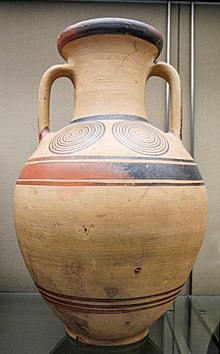Protogeometric ceramics


As Protogeometric ceramic is called the painted pottery of Greek space from between about 1050/00 v. BC and approx. 900 BC After this ceramic, the period of its occurrence is often called the protogeometric period in classical archeology .
The vases are often painted with mostly large, strict geometric patterns. Typical include concentric circles or semicircles, which are usually drawn with a compass . But there are also square patterns. The decorations are strictly based on the shape of the vessel. The individual vase zones are strongly separated from each other. Most of the vessels are round - in the course of the protogeometric period, however, the shapes became increasingly egg-shaped - with an opening in the upper area and lines running around them, divided into several vertical zones. Important vessel shapes are neck amphorae with handles on the abdomen, shoulder or neck, oinochoes , hydria , craters , lekyths , skyphoi , cups and bowls. Towards the end of the period, pyxids , kalathoi , kantharoi and jugs also appeared in Attica .
So far, only very few, almost undamaged specimens have been found.
literature
- Vincent Robin d'Arba Desborough: Protogeometric Pottery (= Oxford monographs on classical archeology 2). Clarendon Press, Oxford, 1952 ( obsolete in parts since the newer finds missing, but only monograph on protogeometric art ).
- JN Coldstream : Greek Geometric Pottery. A Survey of Ten Local Styles and their Chronology. Methuen, London 1968 (2nd revised edition. Bristol Phoenix Press, Exeter 2008, ISBN 978-1-904675-81-5 ).
- Thomas Mannack : Greek vase painting. An introduction. Theiss, Stuttgart 2002, pp. 67-70. ISBN 3-8062-1743-2 .